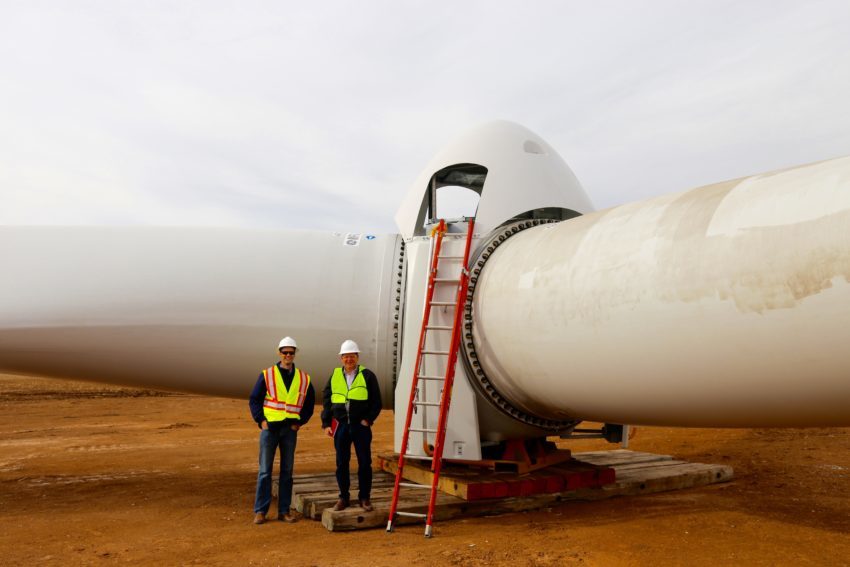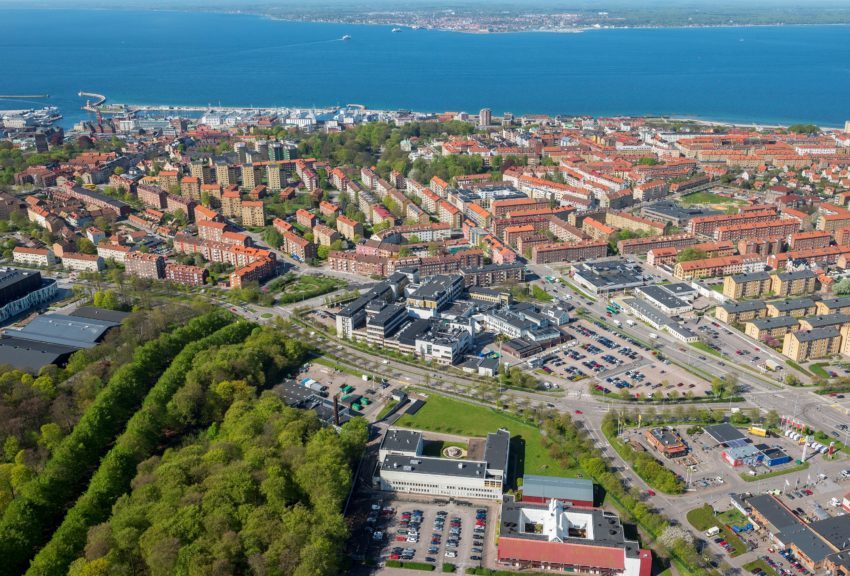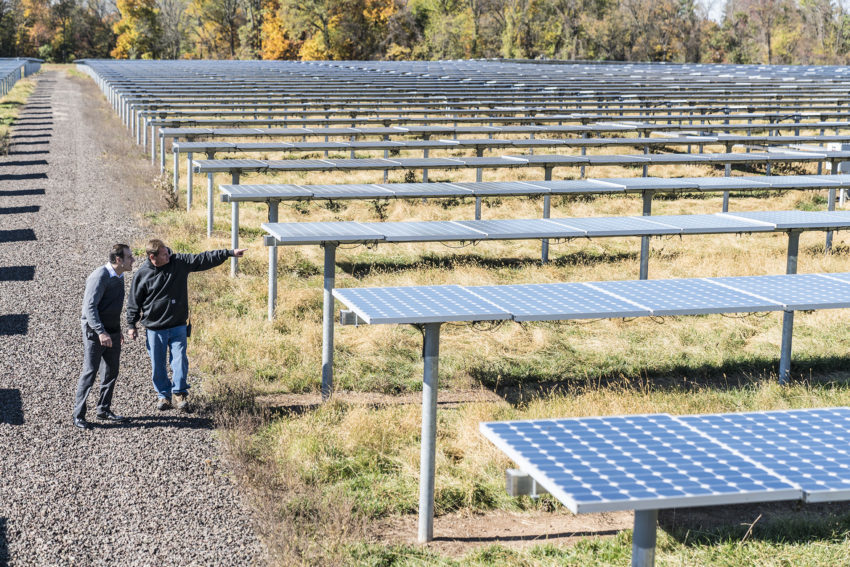Johnson & Johnson, one of the world’s largest multinationals operating in the field of medical devices, pharmaceuticals and consumer packaged goods, has been working adamantly to make its business more sustainable and to reduce its carbon footprint.
In this interview, we speak with Jed Richardson, senior director of Environmental Stewardship for Johnson & Johnson. Jed oversees several sustainability goals related to greenhouse gas emissions, renewable energy and water risk, as well as the company’s global energy procurement strategy. We had the opportunity to speak with Jed about all the actions Johnson & Johnson has taken within these ever-important areas, as well as the company’s plans for the future.
 In the Photo: Solar panels to provide clean energy. Photo Credit: Johnson & Johnson
In the Photo: Solar panels to provide clean energy. Photo Credit: Johnson & Johnson
I have seen Johnson & Johnson is committed in playing its role to help reaching UN’s Sustainable Development Goals adopted in 2015 and that your company had set itself a “RE100 target” for energy use to be 100% renewable by 2050. How is the partnership with RE100 working out the initiative when it was launched in 2014? Do you find it useful to help you go forward, and if so, in what ways?
Jed Richardson: We have very much enjoyed our strategic partnership with RE100. We joined The Climate Group’s RE100 initiative in September 2015 and have found it instrumental in guiding us forward as an organization to help us achieve our commitments of creating long-term sustainable impact for people and the planet. The RE100 team hosts numerous forums on global renewable energy challenges, which have allowed us to connect with other members about policies and share best practices.
The connectivity element is the biggest benefit for us. For example, RE100 hosts events during Climate Week each year which take place over the first week of the UN General Assembly in New York City and brings together key stakeholders in the field. Access to these individuals and organizations has been extremely useful in moving forward with our goals as we learn from the experiences of others.
How does the UN sustainability goals fit into company culture, how long have you been aware of environmental issues at Johnson & Johnson? Do you find that company employees know about the SDGs and are committed to them or do you have to push for greater environmental awareness within the company?
Jed Richardson: Our sustainability approach is inextricably linked to our vision of a world where a healthy mind, body and environment is within reach for everyone, everywhere. We are driven by our mission as a healthcare company and the values set by Our Credo that outline our responsibility to the communities in which we live and work, and to the global community as well. Our employees understand the importance of protecting the environment and natural resources, and this is reflected in how we operate our business and our facilities.
“We Sustain” is our environmental sustainability employee engagement program that invites local teams and employees to collaborate, participate and take action on environmental sustainability initiatives. Employees are invited annually to compete for our Sustainability Accelerator Grants that fund innovative sustainability projects that have the potential to be scaled across our business. We believe it is our people and their passion that will make better health a reality for more people, in more places.
I understand that in just three years you have reached 25% of use of renewable energy. How did you manage that feat? Do you think you can maintain that pace in future or was it, to some extent, the result of “picking the low hanging fruits”? What are the next steps, the upcoming challenges? What do you expect to be a realistic timeline?
Jed Richardson: In 2015, we weren’t seeing the results that we’d hoped regarding renewable energy usage. Although we did a lot of work and invested significantly in renewable energy systems on our properties, it only equated to a very small percentage of our overall electricity needs, and we realised that we needed to “up our game,” so to speak. We collaborated heavily with NGOs and peer companies within the Renewable Energy Buyers Alliance and other groups and ultimately changed our strategy from a build-alone to a build-and-buy approach. We wanted to use our buying power to influence renewable energy investments so we launched a bid process in the United States and selected a 100-megawatt wind farm that was to be built in Texas. After signing a long-term power purchase agreement with the developer of that project, we started taking the output from the wind farm in January 2017, which alone brought our global renewable energy percentage up from about 2% to 25%.
Our current goal is 35% renewable electricity by 2020, which we believe is achievable, followed by a more ambitious goal of 100% by 2050. This is going to be a big challenge for us, as we are a very globally diverse company and there are some countries where you cannot yet procure renewables. It’s a long road, but we’re well on our way.

In the Photo: Installing a wind turbine in a windfarm. Photo Credit: Johnson & Johnson
Johnson & Johnson is a multinational company with offices and factories spread around the world. What are the challenges related to this and your plan to reduce your carbon footprint? Is it easy to push for sustainable energy sources in every single country of the world or are there areas where it is a challenge?
Jed Richardson: Procuring renewable energy can be difficult in certain countries and we have found it to be quite a steep learning curve. For example, in Asia, where some governments own the generation sources and grid, multinational companies may not have access to procure renewables directly. In such cases, we must act as advocates for access in the hopes that our voice, combined with others, will draw attention to the need for policy changes. In terms of areas with access to sustainable energy sources, we have found it most logical to begin in places where we use the most energy and where the regulatory environment allows access to procure renewables. We also look for places where our investment in renewables directly benefits the local economy and leads to further renewable energy development, rather than purchasing low-cost unbundled voluntary renewable energy credits or guarantees of origin from third-party suppliers.
In Sweden, you have achieved a carbon neutral status in one of your sites. How did you accomplish that? Is building a carbon-neutral site and/or one with the least impact possible always a priority for Johnson & Johnson?
Jed Richardson: It’s a unique situation! In Sweden, we were able to procure the renewable energy directly from the local grid. The local team put in a tremendous amount of effort to decrease the energy consumption at that site by approximately 25% since 2010, while production volume increased by 25% over the same time. The location of this property also allowed us to procure biogas, as well as renewable district heating and cooling from the local community. These factors all combined to create the carbon neutral site that we’re so proud of.
We’re currently evaluating opportunities for achieving carbon neutral status at other sites around the world. We’re doing a lot of renewable energy work in Belgium at the moment, including constructing a large geothermal system to bring hot water from deep beneath the earth’s surface to provide our campus with renewable heat and, although carbon neutrality is a long way off, this is certainly a big step in that direction.

In the Photo: Sweden, the coubntry where Johnson & Johnson has acheived a carbon neutral status. Photo Credit: Johnson & Johnson
Looking beyond renewable energy and referring to Johnson & Johnson’s Environment, Health and Safety (EHS) Policy, are there ways in which EHS policy considerations impact or in some way influence your work?
Jed Richardson: We believe that environmental health is a human health issue. Healthy people need a healthy planet. This belief inspires us to run our business with the health of our planet in mind – from how we operate our facilities, to how we engage our suppliers, to how we design our products. We also work with like-minded partners to create impact beyond our business and to advocate for sound environmental policy. A few examples of how environmental health influences our work include:
- Our Sustainable Procurement Program encourages suppliers to measure, manage and reduce their environmental impacts through participation in CDP disclosure
- Our Earthwards® approach for encouraging the development of more sustainable products using fewer, smarter resources
- Our partnership with C40 Cities Climate Leadership Group, which represents 90 of the world’s cities and mayors, helps to advance the impacts of positive climate actions to improved air quality and human health
- Finally, our founding membership in the Climate Leadership Council, a coalition of business and environmental leaders working together in support of a bipartisan climate policy, which is aimed at moving the United States toward a low-carbon economy
Do you think global companies like yours should be leading the way on sustainability, especially regarding the use of renewable energy?
Jed Richardson: Absolutely! As such a large organization, we believe it is our responsibility to lead by example for other businesses as well as individual consumers.
If you look at the renewable energy sector, we’ve been an active participant for nearly 20 years, and have been recognized by the United States Environmental Protection Agency (EPA) Green Power Partnership for our continued commitment to achieve a clean energy future.
In addition to our commitments to renewable energy, we also recently joined the “We Are Still In” initiative – a growing coalition of organizations committed to taking action in the United States in support of the Paris Climate Agreement.
How could your initiatives also promote better habits for your customers?
Jed Richardson: We’re fortunate to have our products used by millions of consumers each day, and as a household name, we carry real power that can be used for good. In 2013, we launched the Care to Recycle program to help consumers increase the recycling rates of personal care products, after research showed that many Americans were not recycling these items. Through this program, we were able to provide fun, engaging tips and tools to help families increase their recycling habits. We hope that by making changes like this and highlighting them to consumers, we will emphasize the need for sustainable habits.



 In the Photo: Solar panels to provide clean energy. Photo Credit:
In the Photo: Solar panels to provide clean energy. Photo Credit: 






